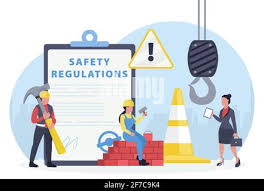With OSHA’s new “walkaround rule” taking effect May 31st, you should know what to do when an OSHA inspector arrives.
Walkaround Rule and a Third-Party
Representative
The new rule empowers OSHA inspectors to let union representatives, community activists, or any other third party join them during an onsite inspection, It can be anyone whom the inspector deems as representing employees and reasonably necessary for conducting the inspection. This is true even if the third parties are not employees and even if the worksite is not unionized.
OSHA regulations limit the number of representatives who can accompany the inspector to one unless more than one will aid the inspection or unless different representatives are used in different phases of the inspection.
Safety and Liability Protections
Whenever third parties accompany an OSHA inspector, there are safety concerns. These third parties must be required to follow all safety protocol, such as wearing hard hats and other PPE.
Employers should be sure to protect themselves from “tort liability,” such as damages for the tort of negligence, because a third party like a nonemployee union organizer is not covered by workers’ compensation. Ask the nonemployee representative to sign a waiver of liability.
Confidential Information Concerns
Although OSHA provides that employers may request that limits be placed in any area containing trade secrets, such a request may trigger additional disputes over what constitutes a trade secret and whether the restriction is appropriate.
Employers may decide to require that third parties sign nondisclosure agreements to protect confidential information viewed during an inspection. Employers should consider identifying the areas they will not let third parties enter on the basis that the areas contain trade secrets.
Property Rights
Employers should understand rights tied to the Fourth Amendment, which prohibits unreasonable searches.
A simple statement to the inspector during the opening conference will bring the warrant requirement to the surface, such as: “We understand the Fourth Amendment applies and, as a result, we understand you need either a warrant or our consent for this inspection to proceed. We are inclined to consent, but before we do, we would like to ensure there is a mutual understanding and agreement on exactly how this inspection will proceed, including who participates.”
Employers should not lose the opportunity to negotiate the scope of the inspection by simply, automatically and mistakenly agreeing with everything the inspector says.
Develop Procedures
Employers should develop procedures for what to do when an OSHA inspector arrives, and train those employees who may interface with the OSHA inspector. This may include:
- Designate someone to meet the OSHA inspector and anyone they bring, as well as accompany the inspector on the walkaround. Note that a third-party representative might be requested during any portion of the inspection.
- Ensure that the conduct of the inspection is not creating an unreasonable disruption.
- Ask the inspector to tell the walkaround representative that matters unrelated to the inspection shall not be discussed with employees.
Prevent Interference with Inspection
Employers should watch for activity by the walkaround representative that does not aid the inspection.
OSHA has examples of activities that interfere with OSHA’s inspection, including:
- Preventing the inspector from interviewing employees in private.
- Failing to stay with the inspector during the walkaround, such as going into unauthorized areas.
- Taking unauthorized photographs or videos.
- Engaging in union solicitation, such as handing out union authorization cards.
- Failing to comply with the ground rules of the inspection.
Disruptive behavior might result in suspension of the inspection or even immediate denial of further accompaniment by the third-party representative.









